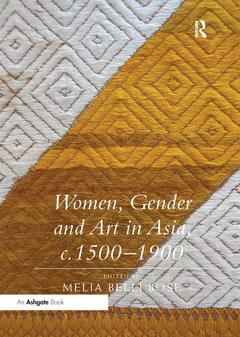Women, Gender and Art in Asia, c. 1500-1900

Women, Gender and Art in Asia, c. 1500?1900 brings women's engagements with art into a pan-Asian dialogue with essays that examine women as artists, commissioners, collectors, and subjects from India, Southeast Asia, Tibet, China, Korea, and Japan, from the sixteenth to the early twentieth century. The artistic media includes painting, sculpture, architecture, textiles, and photography. The book is broadly concerned with four salient questions: How unusual was it for women to engage directly with art? What factors precluded more women from doing so? In what ways did women's artwork or commissions differ from those of men? And, what were the range of meanings for woman as subject matter?
The chapters deal with historic individuals about whom there is considerable biographical information. Beyond locating these uncommon women within their socio-cultural milieux, contributors consider the multiple strands that twined to comprise their complex identities, and how these impacted their works of art. In many cases, the woman's status-as wife, mother, widow, ruler, or concubine (and multiple combinations thereof), as well as her religion and lineage-determined the media, style, and content of her art. Women, Gender and Art in Asia, c. 1500?1900 adds to our understanding of works of art, their meanings, and functions.
Contents
List of Illustrations
Notes on Contributors
Acknowledgements
Introduction: Queens, Courtesans, and Collectors: Women’s Engagement with Art in Asia
Melia Belli Bose
PART 1
Matrons, Art, and Power
1 Mapping Holkar Identity and the Good Name of Ahilyabai
Cathleen Cummings
2 Royal Matronage and a Visual Vocabulary of Indian Queenship: Ahilyabai Holkar’s Memorial Commissions
Melia Belli Bose
3 Heavenly Mistress and Bodhisattva: Visualizing the Divine Identities of Two Empresses in Ming China (1368–1644)
Luk Yu-Ping
4 A Very “Modern” Matron: Phra Rachaya Dara Rasami as Promoter and Preserver of Lan Na Culture in Early Twentieth-century Siam
Leslie Woodhouse
PART II
Women’s Work and Working Women
5 Imagining Du Liniang in The Peony Pavilion: Female Painters, Self-portraiture, and Paintings of Beautiful Women in Late Ming China
Lara C.W. Blanchard
6 Creating Art in Japan’s Imperial Buddhist Convents: Devotional Practice and Cultural Pastime
Patricia Fister
7 Women’s Work: Phulkari, Flora Annie Steel, and Collecting Textiles in British India
Cristin McKnight Sethi
PART III
Depicting the Exemplary Woman
8. Defining a Woman: The Painting of Sin Saimdang
Sunglim Kim
9 Properly Female: Illustrated Books of Morals for Women in Edo Japan
Elizabeth Lillehoj
10 Absence and Presence: Representations of Human and Non-human Females in Tibetan Thangkas
Serinity Young
PART IV
Gender in Liminal Spaces
11 Reconsidering Gender Realms: The Garden as Site and Setting in Late Imperial Shanghai
Kristen Chiem
12 Women Who Crossed the Cordon
Ikumi Kaminishi
13 A Multi-gendered Scandal: The Survival of the Prostitute Meme, Asazuma Boat
Miriam Wittles
Index
Date de parution : 08-2018
17.4x24.6 cm
Date de parution : 07-2016
17.4x24.6 cm


